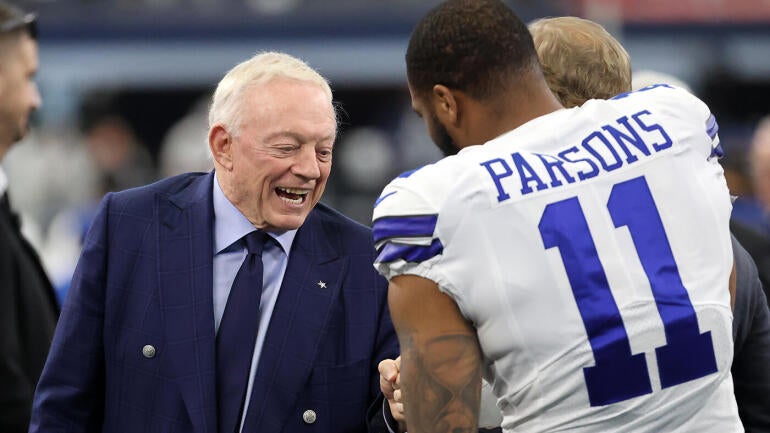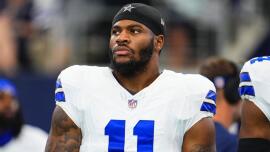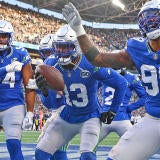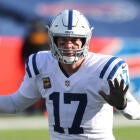
Agent's Take: Putting Jerry Jones' 'handshake' agreement with Cowboys star Micah Parsons into context
Jones doesn't view Parsons' agent as relevant to the negotiation process

It's already been an eventful week for hold-ins. Washington Commanders wide receiver Terry McLaurin signed a three-year contract extension reportedly worth up to $96 million. Edge rusher Trey Hendrickson reached a compromise with the Cincinnati Bengals where he gets a $14 million raise to bring his 2025 pay to $30 million.
The most high-profile contract dispute remaining is between edge rusher Micah Parsons and the Dallas Cowboys. All of the attention turns to the Cowboys. That's exactly how Cowboys owner Jerry Jones wants it.
Jones is adamant that Parsons reneged on a "handshake" agreement they made sometime in March about a contract extension. His repeated insistence that he thought he had a deal contradicts his statements at the NFL annual meeting held March 30 to April 2.
"I know that I've spent five, six hours with him (Parsons) myself and had a lot of discussions. Most of the issues are in agreement, and I've discussed it all," Jones said. "We obviously don't have an agreement relative to a new contract. Micah is under contract. So we'll see how that goes. It's not uncommon for me to visit directly with players, and in this particular case, that's what I'm doing."
In Jones' latest media blitz at the end of last week, he said on former Cowboys Hall of Fame wide receiver Michael Irvin's YouTube channel that the deal he made with Parsons is the richest in NFL history for a defensive player and has the most guarantees. He reiterated this claim in a subsequent interview with ESPN's Steven A. Smith.
Jones has consistently said he had extensive discussions with Parsons about the details of a new contract. Parsons has admitted that a meeting he thought was just about leadership morphed into a conversation where he engaged in some back and forth about what he wanted in a new contract. The 2021 NFL Defensive Rookie of the Year insists that he wasn't having formal negotiations because his agent, Athletes First's David Mulugheta, wasn't involved. Jones doesn't view Mulugheta as relevant to the negotiation process.
Jones didn't mention when in March his talks with Parsons took place. An assumption is being made that Parsons and Jones met in mid-March after the Cleveland Browns made perennial first-team All-Pro edge rusher Myles Garrett the NFL's first $40 million-per-year non-quarterback. The 2023 NFL Defensive Player of the Year signed a four-year, $160 million contract extension with non-quarterback records of $123,596,125 in overall guarantees and $88.8 million fully guaranteed at signing.
Pittsburgh Steelers edge rusher T.J. Watt now sets the defensive player market with the three-year, $123 million extension, averaging $41 million per year, he signed in July shortly before the start of training camp. The deal has a non-quarterback record $108 million fully guaranteed at signing, easily eclipsing Garrett's $88.8 million.
The richest deal for a defensive player and the highest-paid defensive player aren't necessarily one in the same. Garrett's $204,796,125 over six years has been the richest deal since March. This calculation includes Garrett's remaining two contract years for 2024 and 2025 worth $44,796,125 in addition to the $160 million of new money.

Parsons is scheduled to play this season on a fifth-year option. His salary is the subject of a grievance. The Cowboys contend the option should be $21.324 million, which was the 2024 franchise tag number for defensive ends. Parsons feels $24.007 million, the 2024 franchise tag for linebackers, is appropriate.
Jones probably wasn't discussing a four-year contract extension because barely topping Garrett for the richest deal at $205.007 million over five years would be a four-year extension, averaging $45.25 million per year, assuming Parsons' fifth-year option is $24.007 million. This would be a 13.13% increase over Garrett's $40 million per year.
Cowboys quarterback Dak Prescott, who had an extreme amount of negotiating leverage, became the league's highest-paid player by 9.09% last September. Jones wouldn't propose to Parsons a higher percentage increase than Prescott's. Because of these factors, a five-year extension covering six total years seems more plausible.
Jones offering to make Parsons the NFL's second-highest-paid defensive player behind Garrett would be consistent with his treatment of Prescott on his initial veteran contract and wide receiver CeeDee Lamb's contract extension last year. When Prescott signed a four-year, $160 million deal, averaging $40 million per year in 2021, he became the league's second-highest-paid player behind Kansas City Chiefs quarterback Patrick Mahomes.
Lamb's four-year extension, averaging $34 million per year, put him second in the wide receiver salary hierarchy. Justin Jefferson topped the wide receiver pay scale with the four-year, $140 million extension, averaging $35 million per year, he received from the Minnesota Vikings in June 2024.
Jones' willingness to give Parsons the richest contract for a defensive player could have been by a decent margin without making him the highest-paid defensive player. For example, $218.824 million over six years would be a five-year, $197.5 million extension using the lower $21.324 amount for the option. At $39.5 million per year would have been right behind Garrett's $40 million-per-year benchmark that existed in March.
Jones probably wouldn't want to set a new standard for contract guarantees by a similar margin as with overall dollars given that Prescott didn't in a more favorable negotiating environment. Prescott only bested Browns quarterback Deshaun Watson's $230 million in guarantees by $1 million. Out of this $231 million, $129 million was fully guaranteed at signing. Parsons' total guarantees in Jones' offer were likely in the $125 million neighborhood with the amount fully guaranteed around $90 million based on Prescott's dynamics.
The Cowboys prefer lucrative veteran contracts to be structured with large signing bonuses. The deal Prescott received last September included the biggest signing bonus in NFL history at $78,453,333. Lamb's $38 million signing bonus is a record for wide receivers. The first-year base salary is typically at or near the player's applicable league minimum.
San Francisco 49ers edge rusher Nick Bosa holds the record for non-quarterbacks with a $50 million signing bonus. It wouldn't be surprising for Jones to be comfortable with Parsons establishing a new standard for signing bonuses with defensive players. For instance, Parsons getting a $52.5 million signing bonus that's prorated at $10.5 million annually from 2025 through 2029, where his $21.324 million option year salary is lowered to a $1.324 million 2025 base salary, would decrease his 2025 salary cap number to $11.824 million. The Cowboys would pick up $9.5 million of 2025 cap space in the process.
The most recent five-year extensions the Cowboys signed were in 2023 with cornerback Trevon Diggs and offensive tackle Terence Steele averaging $19.4 million and $16.5 million per year, respectively. The structures are somewhat team friendly and backloaded. Diggs' new money percentages after the third and fourth new contract years are 57.22% and 78.35%. It's 58.18% and 78.79% after Steele's third and fourth new contract years. Under a neutral deal, which is neither front-loaded or back-loaded, Diggs and Steele would have been at 60% and 80% after the third and fourth new contract years.
The Cowboys also have a favorable guarantee vesting schedule in Diggs' and Steele's contracts. Their respective third-year base salaries (the second new contract year) in 2025 are guaranteed for injury at signing. Diggs' and Steele's third-year salaries don't become fully guaranteed until the fifth day of 2025 league year. With deals of Parsons' magnitude, it is customary for injury guarantees to convert to fully guaranteed one year early, unlike with Diggs and Steele.
It's hard to imagine Parsons being well-versed enough in this type of contract minutiae. Jones trying to take advantage of Parsons in these areas would be expected.
In sum, the deal Jones is insisting he made with Parsons is probably a five-year contract extension. Jones selling Parsons on the idea of the richest contract in history for a defensive player as a trade off for not being the NFL's highest-paid defensive player wouldn't be surprising.
This could mean a five-year, $197.5 million extension, averaging $39.5 million per year. Whether Parsons' option is worth $21.324 million or $24.007 million, he would have the richest deal for a defensive player. The record-setting total guarantees were likely no more than $125 million and $90 million fully guaranteed at signing. Out of the $90 million, there could be a record signing bonus for a defensive player surpassing Bosa's $50 million.
The deal would be back-loaded. After the first three new contract years (running through 2028), Parsons averaging $38 million per year would be in line with Dallas' preferences. So would $39 million per year after the first four new contract years. Additionally, money guaranteed for injury only at signing wouldn't be practically fully guaranteed by vesting a year early.
It's understandable why Mulugheta wasn't interested in validating anything Jones discussed with his client given Dallas' contract preferences. Jones was likely speaking figuratively not literally about Mulugheta supposedly telling the Cowboys to stick the details of the contract with Parsons up their ass.
There's good reason for Jones wanting to keep Mulugheta out of the process. Parsons becoming the NFL's highest-paid non-quarterback is probably a necessity for Mulugheta. Jones surely recognizes that Mulugheta will balk at a longer-term extension. Mulugheta will likely be adamant that Parsons' extension should be four years, just like in Lamb's and Prescott's cases, with a favorable guarantee vesting and player-friendly cash flow.

















